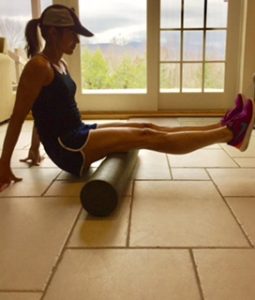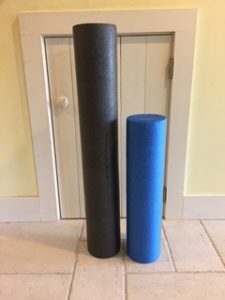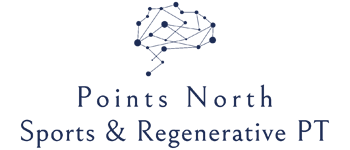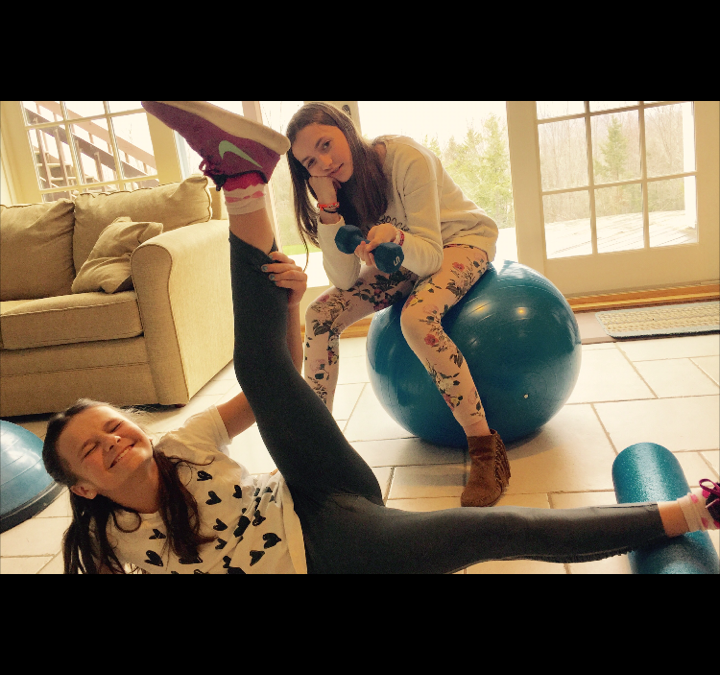Some Directions For Navigating The Confusing World Of Fitness
Question from the audience: My hamstrings are so tight, and I stretch and stretch but they don’t seem to loosen up. My personal trainer says that stretching is bad for you and I should foam roll them instead. But then my tennis pro said that the best way to loosen up is with gentle mobility, i.e. lunges with gentle trunk rotation, and my massage therapist says that my hamstrings are weak and I should strengthen them. So what should I do? Should I start doing yoga?
A: You sound like an active person, and I give you a lot of credit for trying to take care of yourself as well as questioning all the conflicting advice you are receiving. Welcome to the fitness jungle! It is a very trendy place, where new fads abound that are not necessarily backed by research, and are tossed around by lots of people with varying credentials and experience. You will hear completely different advice from your personal trainer, members of your exercise class, and dudes in the weight room at the gym.
From your question, I am assuming that in addition to all of the above, you also have some sort of regular cardio workout thrown in there somewhere, possibly running or biking, if your hamstrings are tight. Good for you for trying to stretch your hamstrings. Flexibility is a component of fitness that frequently is neglected because there are only so many hours in a day, and we think we don’t have time for it. The fact of the matter is that flexibility helps to protect you against injury, wear and tear on your joints, and spinal alignment issues, and also aids your strength by establishing improved length-tension relationships of the muscle fibers.
These activities that you mentioned are all different interventions for flexibility, and all have validity. Depending on your physical condition, medical history and injury status, and personal preference, however, not all of them may agree with you. So I’m going to give you the dirt as well as my flashes of brilliance on each:
Stretching
Stretching is not inherently bad for you. It, is in fact, backed by research as an appropriate exercise for increasing soft tissue extensibility and general mobility. It is used widely in traditional physical therapy, both as an intervention that clients are instructed to perform and as a treatment administered by PTs on clients. But: there are guidelines to be observed.
A gentle stretching regimen for improved general flexibility that addresses all major muscle groups is fine for most people. Stretching tight muscles is never comfortable, and people experience the sensation differently. Some think that stretching feels fabulous, other experience it as a form of torture. You should ease gradually into a stretch, no quick or forceful movements, and you should not feel sharp pain or push into discomfort. When I played varsity soccer in high school, the school athletic trainer would stretch our legs to the point where we complained that it hurt and then push farther. This is not a good idea! Hold the stretch for a minimum of 30 seconds; a minute would be even better.
Some situations in which it is not a good idea to stretch include an acute spinal injury with or without radiating pain into an arm or leg, as stretching tends to further irritate already irritated nerves; stretching around an unstable joint, such as a shoulder which has been dislocated; or stretching a recent surgical site or an acutely inflamed, swollen joint.
If you tell me that you are stretching and stretching your hamstrings and they are not loosening up, then then one or more of several possible scenarios is occurring. It’s possible that you are not holding the stretch long enough or performing the stretches frequently enough. More likely is that you are stretching the hamstrings but the rest of the chain, which should include your neck, mid back, low back, gluteal and piriformis muscles, and your calves. If you are stretching nothing else other than your hamstrings, then chances are that the entire posterior side of your body is tight and you are simply cranking on a weak point in your hamstrings when you stretch, which is doing you no good.
A couple of other reasons why you might be getting nowhere with stretching your hamstrings are 1) a history of recurrent hamstring strains, or 2) an underlying low back or sacroiliac condition. Recurrent hamstring strains can create restrictions and scarring in the fascia—the tough connective tissue that surrounds and compartmentalizes muscles, organs and other structures throughout the body. Fascial restriction will limit flexibility, and in this case foam rolling may work better for you, and we’ll discuss that in a minute. A history of recurrent strains also may indicate that your hamstrings are in a reflexive state of muscle contraction to prevent further injury, and in this case you should seek some treatment.
A low back issue is a very common contributor to hamstring tension, and while not necessarily pathological or even serious, it does deserve some attention. It’s possible that you’ve been ignoring it for a while, or that your trainer, friend, or random guy at the gym told you that if you stretch your hamstrings then your back pain will go away. My PT experience is that this principle tends to operate in reverse—that when you address the root cause, which is the back issue, you will find that your hamstrings are not as tight. You may in fact be suffering from recurrent hamstring strains as a result of the low back condition, and that’s a good topic for another blog.
In case you were wondering, we’re using hamstrings as a common example but we aren’t just talking hamstrings here. If you really have been stretching and stretching a tight area of your body and do not feel any improvement, chances are that either you haven’t been doing it correctly, or that there is an underlying issue contributing to the tension. Both situations merit a look by a health professional.
Yoga
If you haven’t really done much stretching and have absolutely no idea what you’re doing, it isn’t a bad idea to sign up for a session with a qualified personal trainer. Possibly a better idea is to attend a gentle, beginner yoga class with a good, qualified instructor, one who is attuned to form and who has worked with injury, to learn some gentle, full body stretching and breathing techniques. I am happy to make some recommendations in the greater Stowe area. The thing to not do is blast off with an aggressive yoga class and try to keep up with people who have been in the class for years. I’ve amassed quite an impressive collection of clients in the practice over the years who have injured themselves taking this approach.
True yoga people, who have trained with a certain method, earned a certification and who practice in their personal lives, know what they are doing and how to instruct you. Unfortunately there are instructors out there who are teaching but do not have the background, and it’s important to find out this information ahead of time. Yoga has benefits beyond flexibility, including but not limited to stress reduction and balance training. It has strengthening benefits as well, although the good yoga instructors that I know incorporate other forms of exercise into their practice for additional strengthening. If you are mainly interested in flexibility but do not have time to work an additional class into your regular routine, attending a few beginner classes or doing a private session with an instructor is enough to get you going with an independent routine for flexibility.
It is possible to take yoga principles and incorporate them into a routine for general flexibility, and this is the approach that I use, in instructing others in a flexibility regimen as well as in my own flexibility training. I see the best results with a sort of a “flow” method consisting of gentle, multi-joint stretches originating from the core. The client is in constant, slow motion, slowly lengthening muscle groups in one area and then transitioning into another position to address another muscle group. It is gentle, fun, and feels great. Thanks, yoga people!
Foam rolling
Foam rolling is by nature a rather aggressive form of soft tissue mobilization, and people tend to either love it or hate it. It absolutely is not for everyone! We could write another entire blog on this piece of equipment alone. Foam rolls come in different length, diameter, textures, density, and color options which are endlessly confusing. I recommend the 3 foot length, 6 inch diameter as the most practical size to get. In general, the black rolls have the highest density with a relatively firm, hard surface, followed by the blue rolls, and then the white rolls tend to be the most forgiving. There also are rolls with little spongy bumps on them, which I see as more of a massage tool than a flexibility, but it’s a free country, and you can get whatever you like.

The theory behind the utility of a foam roll is that rolling a segment of your body on the foam roll mobilizes the muscles and more importantly, the fascia at the micro level and possibly increases the mobility of the soft tissue more than stretching. Geeking out here for a minute, fascia is a non-contractile, viscoelastic structure which results a stretch and is more easily mobilized with a slow, gentle, consistent pressure held over a period of time. Therefore, the foam roll may be useful in mobilizing the fascial scarring in hamstrings that we discussed above. I also find the roll useful in situations where stretching is contraindicated, such as when a client recovering from sciatica or a bad hamstring strain should not be stretching but is experiencing a lot of discomfort from myofascial tension. It also is useful for stretching areas of the body that are tough to figure out how to stretch, such as your anterior shoulders and chest. The roll also can be used for gentle spinal mobilization in clients who have been properly instructed in said technique, by me.
The tricky part of foam rolling is that you need to know exactly how to accomplish whatever it is that you’re trying to do, and if you’re trying to lengthen and relax a muscle, there’s a technique to it. Quick, back and forth movements will stimulate the muscle spindle sensory receptors in the muscle and cause the muscle to contract, tightening it further and opposing what you are trying to accomplish. So if you are trying to stretch and lengthen a muscle, you should roll it in a gently lengthened position, with a slow, firm motion for the entire length of the muscle. This technique will stimulate the Golgi tendon organ sensory receptors located in the tendinous attachment of the muscle, which will oppose the muscle spindle and allow the resting muscle tension to relax.

Many people find the pressure of a foam roll on a tight or sensitive area excruciating, and in these cases it most likely is doing more harm than good and they should not try to power through it. I’m thinking in particular of iliotibial band rolling, which is a particularly macho maneuver that people love to do, sweating and grimacing their way through it. The iliotibial band does not just get tight; in the absence of a traumatic injury directly to the IT band (for example, I had a client with an IT band hematoma resulting from a skiing injury), IT band tension is 100 percent of the time caused by an alignment issue of the pelvis, which needs some PT or chiropractic intervention and not foam rolling. Other people who should stay off the foam roll are those with osteoporosis, anyone with instability in their spine or another joint, fragile skin or poor balance. For those who think that foam rolling might help them but find the pressure of the roll to be too much, tennis balls or yoga balls frequently are more tolerable. You can make a softer roll by rolling up a giant wad of towels.
A dramatic pause here to vent about something that annoys me: Foam rolls are marketed these days as a “self-myofascial release” tool. There’s absolutely no comparison between foam rolling and myofascial release. Myofascial release is by definition a hands-on technique that requires advanced manual skills and an energy transfer. A foam roll may help you to lengthen smaller areas of restricted soft tissue than a stretch does, but let’s not assign a cheap roll of industrial material a skill it does not have. So if you’ve been told by a doctor that myofascial release may help your migraines, please don’t dash over to the gym or a sporting goods store so you can start foam rolling your head.
Gentle Mobility
Probably seven years ago, the latest from the fitness industry was: “Start your workouts with gentle mobility! If you stretch before a workout you might strain a muscle!” I don’t believe that I’ve ever actually met anyone who had that happen, but I will say that gentle mobility at the beginning of a workout, particularly an early morning workout, to boost your circulation to your muscles and joints is a good idea. Walking, slow jogging, marching in place and swinging your arms, and lunge walking all are examples of gentle mobility. This is a case where there’s really no amazing science and personal preference rules. Some runners I know have been stretching before their runs for 30 years, think it helps them and never will change their routine. My own personal approach varies. I tend to favor a long, slow warm up when I begin a workout, but some mornings I feel the need to stretch out so I can move adequately to accomplish a long, slow workout. I think that for those who want to incorporate a little of everything, gentle mobility at the beginning of a workout, and stretching and foam rolling at the end of a workout when your tissues will be more extensible due to the circulation boost and movement they’ve received, makes sense.
Strengthening
If you’ve read anything I’ve written in the past, then you already know that strengthening is a point on which I am absolutely non-negotiable. Everyone should be doing some strengthening, and it is especially important for the age 40 and over crowd. The U.S. Department of Health and Human Services developed physical activity guidelines in 2008 based on an extensive review of scientific research, and recommends that all adults should perform muscle-strengthening activities of moderate or high intensity involving all major muscle groups, 2 or more days per week. That is approximately 8 to 12 strengthening exercises, a minimum of 2 days per week. So it makes no difference to me who told you which muscle is weak, but you should be on a general strengthening program, and a PT or a personal trainer can get you started.
Back to flexibility and strengthening: A strength assessment is part of a full evaluation of physical condition which takes time and really cannot be accurately assessed visually, although those of us trained in kinesiology can take an educated guess. But a muscle that needs some strengthening can be tight; when it is weak and fatigued, it can develop a reflexive spasm which is your nervous system’s way of trying to protect it by keeping it in a contracted state. The reverse also is true, that a tight muscle can lack strength. If you’ll allow me to geek out yet again, it can happen that a muscle is so tight that the sarcomeres, which are long, parallel oriented fibers in the muscle that lengthen or contract in response to a nerve signal, can be in a state of “active insufficiency.” In this state, they are permanently in a shortened position and cannot contract efficiently without some flexibility intervention. So before you stampede to the hamstring curl machine (a largely useless machine anyway except performed in a certain way for certain conditions, and good for a future blog topic), think about having a PT evaluation to help you sort out the cause of your tight hamstrings.
So what should you be doing? The answer is possibly a little of all of the above, and I’m sorry to be the one to inform you that fitness and taking good care of ourselves just gets higher maintenance as we get older, but I promise you that the effort is well worth it! The other good news is that you don’t have to spend endless amounts of time on flexibility training. A general picture of how you could structure your workouts would be to warm up with 5 minutes of some gentle mobility exercises, with or without gentle stretching depending on your preference. Then end your workout with 5 minutes of some gentle stretching and/or foam rolling, also dependent on your preference as well as injury status, at the end of your workout. I do think that you will get the most flexibility benefit from performing the stretching and foam rolling immediately following your workout and that this practice will help prevent aches and pains later in the day. If you absolutely, positively feel pressed for time, you can do some stretching and/or foam rolling later in the day, or even throughout the day, if you promise to make it a regular, daily habit. And you absolutely must carve out half an hour at least twice a week (three times a week would be even better) for some independent strengthening, and whether that’s at home or in the gym or elsewhere is up to you. A strengthening class is fun but will not meet all your individual strengthening needs.
Stick with it and don’t get too distracted by all the circulating trends and well-intentioned misinformation out there in the fitness jungle. You can always e-mail or Facebook message me if you have any questions. I’m always happy to help!
–Kathleen Doehla, M.S. P.T.

